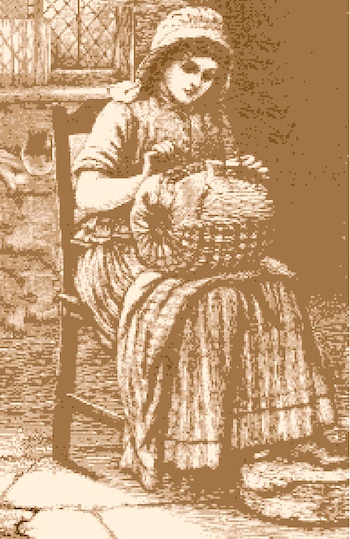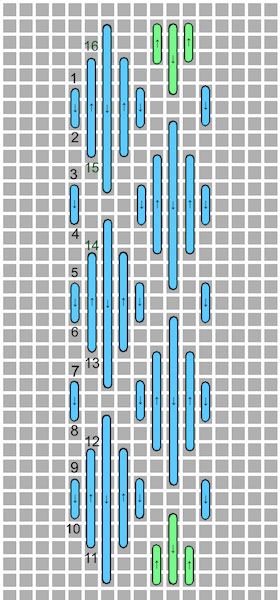- Home
- Intro to blackwork
- Blackwork Embroidery
Simple blackwork embroidery shading techniques
Blackwork embroidery, a counted thread embroidery, is often stitched with black thread on a white evenly woven fabric, but adding some color can really make the design stand out.
This embroidery technique is sometimes called Spanish blackwork or Elizabethan embroidery.
The pears in this article, will allow us to explore how the addition of extra stitches within a pattern can add depth and shading, as can using more strands of floss in the needle.
If you haven't tried blackwork before, you might find my Blackwork for Beginners ebook helpful, to teach you the basics.

Design size
This design measures 3.3 x 3.9 inches when worked on 14 count Aida. The stitch count is 46 x 54.
You will need
- 8 x 7 inch piece of Aida 14 (or even weave fabric if you prefer)
- DMC 470 stranded embroidery floss (or you could use silk thread)
- Size 24 tapestry needle
- 6 inch embroidery hoop (optional)
The downloadable pears chart
Download the pdf chart from this link. Black arrows along the top and left-hand side of the chart mark the mid-points, and if you follow the red lines across you will find the center of the design.
Fold your fabric in half both ways and press to form a crease that temporarily marks the center.
If you count up 12 lines from the center of the fabric and then 3 to the left you will be in position to begin the bottom cross stitch of the right-hand stem.
Cross stitching the stem
Work the stem of the pears in cross stitch using two strands of embroidery floss. If you have not done cross stitch before, you might find my beginners tutorial helpful.
Stitching the Outline
Blackwork embroidery is easiest if you work the outlines first, using 2 strands of floss, in either a backstitch or double running stitch (also known as Holbein stitch).
If you are confident with your counting, you can start your thread with the loop method, otherwise I suggest leaving a tail which you can fasten off later. This way you can undo your work from the beginning if you make a counting mistake that you don't notice immediately.
Working the blackwork repeating pattern

I suggest using 1 strand of embroidery floss to give a delicate appearance to the geometric blackwork pattern. You might find these referred to as diaper patterns in older publications such as the classic book by Elisabeth Geddes called Blackwork Embroidery that was reprinted in 1976.
We will treat each "flower" on its own and then move on to the next in a diagonal row. Diagram A, shows the first "journey" around the flower, working every other running stitch. For the moment, ignore the centre of the flower.

Next, go back around the flower, filling in the missing stitches. This time pop in the horizontal and vertical stitches that meet in the centre of the flower, as in Diagram B, left.
When you complete each flower, move on to the next in that diagonal row. Use the outlines to carry the thread from one row to the next. You can weave under the outline stitches for a short distance without it becoming too obvious on the back of the work.
Shaded blackwork areas

To add shadow and depth to the design, shade some areas by adding extra stitches to the blackwork embroidery using two strands of floss.
Tackle these in two stages. Some flowers have extra stitches in their centers. Work these at the same time as the flowers as shown below.
The photograph, worked in red thread, shows 3 completed flowers and the initial steps of the fourth. The additional stitches are placed in the center to


Finally, we have the "squares" in between our flowers in places. Follow the chart carefully and stitch some completely and others only partly.
To stitch these you can either make four cross stitches and box them in or work them entirely in Holbein stitch.
Congratulations on finishing your first piece of shaded blackwork embroidery.
You can see this pattern in use for the dress of my medieval lady, Gwendoline one of my downloadable blackwork embroidery patterns.
What did you think of this page?
Did it give you all you needed or did anything else spring to mind? If there was something missing give me a shout – or let me know if this page proved helpful (do let me know which page you are commenting on).
Would you like a direct reply? Just pop your email address below, and I'll be in touch.
Stay connected between projects
If you’d like occasional updates from my embroidery room, including new patterns, gentle tips, and little things I think you might enjoy, you’re warmly invited to join the Stitchin’ Times newsletter.
No pressure. Just a friendly note now and then to keep you inspired.














